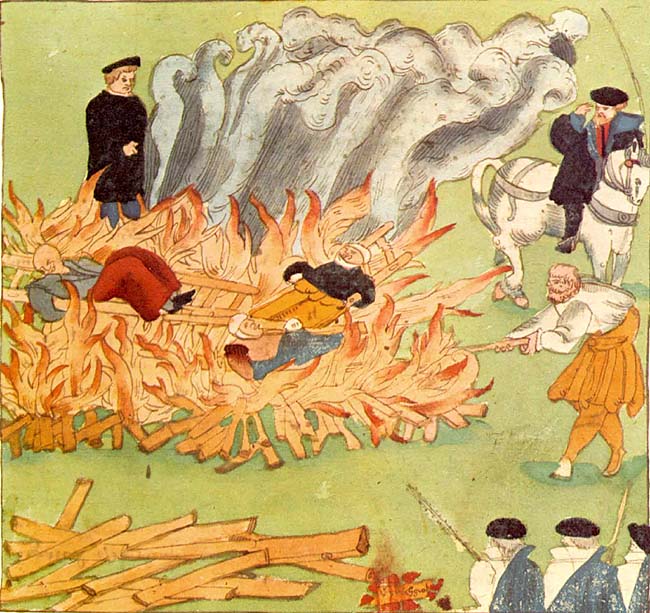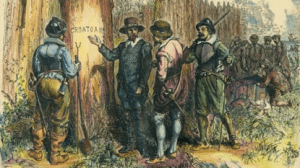In today’s world, when someone thinks of a witch, they normally picture one of a few things: the infamous Wicked Witch of the West that was out to get our beloved Dorothy; Bette Midler’s crazy looking character in Hocus Pocus; or a sparkly, purple and black ‘Party City’ outfit that young girls wear as a sort of ‘right of passage’ Halloween costume. Some may even think back to their high school history lessons about the Salem Witch Trials during the late 1600’s in colonial America. These images, however, are drastically different from those a 15th-century European would have pictured. They would have conjured up the image of a woman who wasn’t religious, who went against social norms, who had supernatural powers, and who therefore was most definitely associated with the devil.1 These Europeans would have pictured the faces of the many women accused and killed in the witch hunts of the time that were in large part driven by skewed societal perceptions, religious fears, and hysteria.
The witch hunts in Europe occurred on a much larger scale than those that took place in Salem Village. Records suggest that the hunts began as early as the 14th century and went on until around 1650, gaining the most momentum during the late 15th century. In total, the executions of supposed witches by Europeans numbered between 200,000 and 500,000, with 85% or more of those accused of and executed for witchcraft being women.2 Additionally, around 95% were specifically poor, old, single, or widowed women.3 Based on social perceptions of the time, these numbers, quite frankly, are not surprising. It is said that “heresy evidence, a major element during the dominance of the European witch craze, was that Satan recruited servants, mostly women, by signing a pact with them and turned them into his sexual subordinates.”4 It was understood by society members that these women who made such a pact with the devil were “female witches [given] the opportunity to commit evil deeds,” and that as a result of their pact and evil-doings, “[their] souls…belonged to the devil, and these women would serve in hell upon their death.”5 Society members also understood that single, elderly, poor, and/or widowed women were outcasts, and in some cases were even thought to be living sinful lives. The perception of all women as impressionable, and the perception of certain types of women who were generally unaccepted, contributed largely to the witch craze in Europe.
Perhaps the biggest factor that fueled the witch hunts of the time, however, stemmed from the religious conflicts of the age. Fifteenth-century Europeans were extremely devout Christians, and often viewed anything different as a threat to their religion. A common belief among many was that certain people possessed supernatural powers, and at the end of the fifteenth century, pronouncements from the era’s theologians began to circulate. They suggested that those who possessed diabolical powers were witches and drew their abilities straight from the devil himself.6 These beliefs were intricate, and included details about supposed witches flying to foreign places on broomsticks to attend a witch’s Sabbath, worship the devil, create special potions, and even engage in sexual relations with the devil.7 As a result of these beliefs, assumptions and rumors began to spread, mostly whenever something unexpected or inexplicable happened, that the event had been caused by a witch. These bad events ranged from crop failures to a woman’s inability to conceive.8 Given this extreme characterization, it becomes evident that Europeans of the time took witches, their powers, and their relationships with the devil very seriously. But why? What led to the widespread fear, accusations, and killings of witches in Europe?

As mentioned earlier, Europeans did not take their religious beliefs lightly, and any threats to Christianity were treated with utmost scrutiny. Additionally, because the religious wars between Catholics and Protestants occurred during the same time at which the witch hunts peaked, nothing was more concerning to a European Christian than someone who threatened their form of Christianity. British historian Norman Cohn summed up the need for Europeans to find and kill witches as “the need to create a scapegoat for an unacknowledged hostility to Christianity.”9 In this context, it may be understood that Europeans of the time were influenced–probably by the religious wars that were happening in their homelands at the time–into believing that these conflicts were a result of witches and their relationships with the devil. Other common religious beliefs that helped to fuel the fear and persecution of supposed witches included the “religious-driven conception of the relationship between demonology and witchcraft,” which elicited a belief “that the world served as a battlefield upon which an ongoing struggle between Satan and God was portrayed.”10 In a society where such a common–and detailed–belief regarding the continuous war between God and the devil was prevalent, it makes sense that rumors of witches would cause fear enough to spark the type of witch hunts that took place in Europe between the fourteenth and sixteenth centuries. Furthermore, the witch hunts took place during the heat of both the Protestant Reformation and the Catholic Counter-Reformation; therefore, those who followed the Protestant or Catholic faiths were primary targets.11
It is said that Protestant authorities who searched for and prosecuted witches acted more harshly than did authorities of the infamous Spanish Inquisition.12 Catholic witch hunting leaders also went out of their way to condemn witches by publishing the Malleus Maleficarum in 1487; this document made “demonology a severe offense punishable by religious and subsequently secular authorities.”13
For these reasons, the witch hunts were widespread throughout Europe and lasted for over 200 years. Although widespread across all of continental Europe, they were generally concentrated in areas where Catholics and Protestants lived in close proximity to each other. In most cases between the fourteenth and sixteenth centuries, the hunts occurred in waves. Catholic lands in Germany were hit with a wave in the 1560s and 1570s, and again in the 1610s and 1620s; large waves occurred simultaneously throughout small communities within the Holy Roman Empire.14 Protestant lands affected the most were Scotland and the Swiss territory of Vaud, conducting nearly 3,000 executions combined.15 Those accused of witchcraft were made to stand trial and were, more times than not, found guilty and executed by hanging or burning.16 In some cases, accused witches were even tortured and forced into making confessions.17

As with other targeted mass killings throughout history, it can be noted that the European witch hunts that took place between the fourteenth and seventeenth centuries were largely influenced by several social and political factors. Most evident are the religious views, opinions, and hostilities that existed among European communities and peoples at the time. Furthermore, the fact that a majority of those witches accused and executed were women who were viewed as being outside societal norms suggests that they were persecuted for reasons of social standards and class influence. Overall, this dark period in European history was clouded with judgement, fear, and religion-fueled wars that–in one way or another–led to the execution of hundreds and thousands of supposed witches. Whether or not the executed were actually witches, we may never know. One thing that is almost certain, however, is that the lesson of redefining moral boundaries that should have been learned from the European witch hunts, instead went unnoticed, allowing similar persecutions to occur in the New World less than fifty years later.18
- Jerry H. Bentley, Herbert F. Ziegler, and Heather E. Streets-Salter, Traditions & Encounters: A Brief Global History from 1500 to the Present, Fourth, Vol. 2 (New York: McGraw-Hill Education, 2016), 376. ↵
- Nachman Ben-Yehuda, “The European Witch Craze of the 14th to 17th Centuries: A Sociologist’s Perspective,” American Journal of Sociology 86, no. 1 (1980): 1. ↵
- Jerry H. Bentley, Herbert F. Ziegler, and Heather E. Streets-Salter, Traditions & Encounters: A Brief Global History from 1500 to the Present, Fourth, Vol. 2 (New York: McGraw-Hill Education, 2016), 376. ↵
- Nachman Ben-Yehuda, “Witches,” in Encyclopedia of Death & the Human Experience, edited by Clifton D. Bryant and Dennis L. Peck, Vol. 2 (Thousand Oaks, CA: SAGE Publications, 2009), 996. ↵
- Nachman Ben-Yehuda, “Witches,” in Encyclopedia of Death & the Human Experience, edited by Clifton D. Bryant and Dennis L. Peck, Vol. 2, (Thousand Oaks, CA: SAGE Publications, 2009), 996. ↵
- Jerry H. Bentley, Herbert F. Ziegler, and Heather E. Streets-Salter, Traditions & Encounters: A Brief Global History from 1500 to the Present, Fourth, Vol. 2 (New York: McGraw-Hill Education, 2016), 376. ↵
- Jerry H. Bentley, Herbert F. Ziegler, and Heather E. Streets-Salter, Traditions & Encounters: A Brief Global History from 1500 to the Present, Fourth, Vol. 2 (New York: McGraw-Hill Education, 2016), 376. ↵
- Jerry H. Bentley, Herbert F. Ziegler, and Heather E. Streets-Salter, Traditions & Encounters: A Brief Global History from 1500 to the Present, Fourth, Vol. 2 (New York: McGraw-Hill Education, 2016), 376. ↵
- Madeleine Jeay, “French ‘Witches’ (14th–16th Centuries),” in Women in World History: A Biographical Encyclopedia, ed., Anne Commire (Detroit: Yorkin Publications, 2002), 774. ↵
- Nachman Ben-Yehuda, “Witches,” in Encyclopedia of Death & the Human Experience, eds. Clifton D. Bryant and Dennis L. Peck, Vol. 2 (Thousand Oaks, CA: SAGE Publications, 2009), 996. ↵
- Alfred J. Andrea, and Carolyn Neel, eds., “Witch-Hunting in Western Europe: Trial by Ordeal–Witch-Hunts and Methods of Extracting Confessions,” World History Encyclopedia (Santa Barabara, CA: ABC-CLIO, 2011), 880. ↵
- Alfred J. Andrea, and Carolyn Neel, eds., “Witch-Hunting in Western Europe: Trial by Ordeal–Witch-Hunts and Methods of Extracting Confessions,” World History Encyclopedia (Santa Barabara, CA: ABC-CLIO, 2011), 880. ↵
- Alfred J. Andrea and Carolyn Neel, eds., “Witch-Hunting in Western Europe: Trial by Ordeal–Witch-Hunts and Methods of Extracting Confessions,” World History Encyclopedia (Santa Barabara, CA: ABC-CLIO, 2011), 880. ↵
- H. C. Erik Midelfort, “Witchcraft,” in Europe, 1450 to 1789: Encyclopedia of the Early Modern World, ed. Jonathan Dewald, Vol. 6 (New York: Charles Scribner’s Sons, 2004), 223. ↵
- H. C. Erik Midelfort, “Witchcraft,” in Europe, 1450 to 1789: Encyclopedia of the Early Modern World, ed. Jonathan Dewald, Vol. 6 (New York: Charles Scribner’s Sons, 2004), 223. ↵
- Jerry H. Bentley, Herbert F. Ziegler, and Heather E. Streets-Salter, Traditions & Encounters: A Brief Global History from 1500 to the Present, Fourth, Vol. 2 (New York: McGraw-Hill Education, 2016), 376. ↵
- Madeleine Jeay, “French ‘Witches’ (14th–16th Centuries),” in Women in World History: A Biographical Encyclopedia ,ed. Anne Commire (Detroit: Yorkin Publications, 2002), 774-775. ↵
- Nachman Ben-Yehuda, “The European Witch Craze of the 14th to 17th Centuries: A Sociologist’s Perspective,” American Journal of Sociology 86, no. 1 (1980): 24-25. ↵



138 comments
Madeline Chandler
This was an extremely well written article, and it was so detailed. The fact that witch hunts existed was devastating and those women were innocent. They were pawns used to assert religious control and power. I have learned some about the Witch hunts in Europe, but never this detailed. The dark time in Europe prompted the dark times of witch hunts in Europe all on the grounds of religious control.
Vianne Beltran
Hi Victoria,
I’ve only ever learned about the witch hunts in America, specifically Salem. Only recently did I begin to realize that there must’ve been witch hunts in Europe too of course. It’s interesting to see how places that held higher proximity of Catholics and Protestants had more witch hunts than other places. I wonder if those reasons would leak into why the American witch hunts would happen or if it had nothing to do with the religious conflict.
Mariah Podwika
This was a really cool article to read! A lot of what people know of witches and witch hunts are from the Salem Witch Trials but there were lots of other women who lost their lives to the same ideas in different areas of the world. The way that witches are portrayed in modern media is a lot different than what they were actually like, most of the women who were accused of being witches were just normal women. This idea also points to a bigger issue that happened a lot in history and that’s the destruction of things and people that didn’t necessarily fit the “norm” of the time. The fact that older, unmarried women were the main target highlights how easy it was for the majority to gang up on a group that they didn’t like to blame them for things that are going wrong for them.
Hailey Lechuga
Great article! It’s always very interesting to learn about the inspiration behind the green-skinned and long nosed woman flying through the air on a broomstick that we all associate with witches. I had never known that the women that were actually targeted during the witch trials were poor, old, widowed, or did not follow religion, rooted by the war between Catholics and Protestants. Religious and political pressures are still dictating how a woman should live her life, to this day.
Celeste Loera
Great article! It is still so mind boggling to me how back then many thought women were witches because they did not fit the ideal norm of a woman in society. If you were old, poor and a widow you would have a big target on your back. It is crazy how people lived in ignorance and fear and accused many women of being witches, and I did not even know there was a protestant v catholic war at the time either which also played a big role.
Santos Mencio
A very interesting article that provides a great deal of clarity on the Witch hunts in Europe. The contention between Catholics and Protestants is fascinating and the implications of it are important to understand. The idea that outcasts could so easily be targeted as scapegoats for a larger issue is something we should strive to never repeat and we need to recognize the causes of these events.
Hoa Vo
Great article! Through it, we can see the superstition and ignorance of people that they delusion and blindly accused many innocent women as witches who harmed their life. Because of the misconception in their belief, their religious fear, it is sad to see that women inherently had no voice in the society were trampled even more
Eva Lizarraga
It was so interesting to learn about how the Protestant vs. Catholic tensions had a lot to do with the intensity of the witch hunts. Although being firm in one’s beliefs is admirable and a good thing, it’s also important to be educated and open-minded. Also, the fact that the main targets were women who did not fit the societal standards was pretty disturbing to read about, and it gives yet another example of how the people who don’t fit the “ideal woman” image have been mistreated and discriminated against in history.
Paula Salinas Gonzalez
I think that this article is very important because we often only tend to think about the Salem Witch Trials as the only witch hunts that ever happened. It’s really hard to believe that European witch hunts actually happened in the 15th century. It is especially difficult to believe all those atrocities happened because of the evidence that justified them. Basically, women who weren’t young and married were targets, which really makes me think about the discrimination that went on. Women who didn’t fit the ideal image of how a woman should be, were thought of as witches.
Seth Roen
And people say these days are stressful and filled with zeolites. At least we are not back in a time when Witch Hunts involving “witches” and end with a person killed for it. Something that did not help was that of the Wars of religion in Europe at the time. While also a less than fair justice system that valued repentance over evidence. So things can be worst; we could be living during the European Witch Hunts.